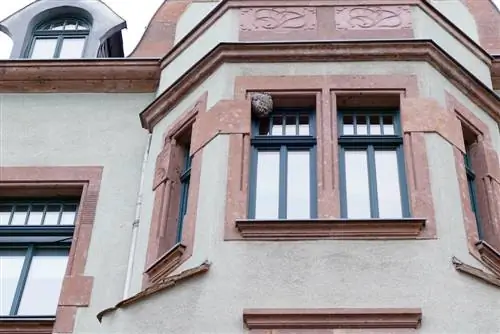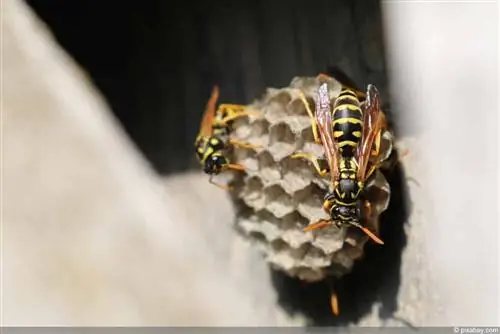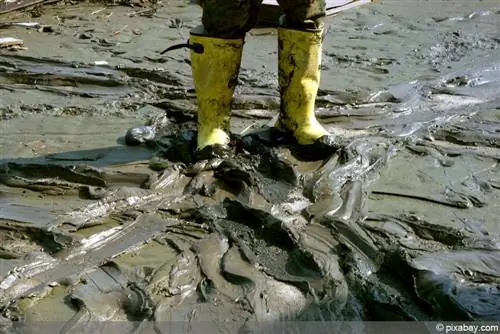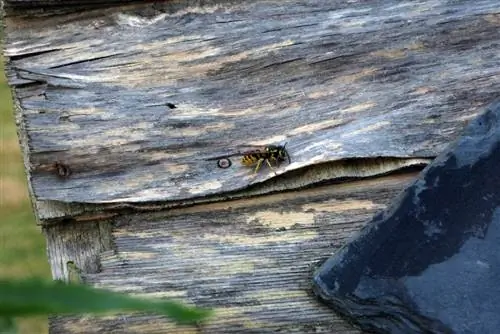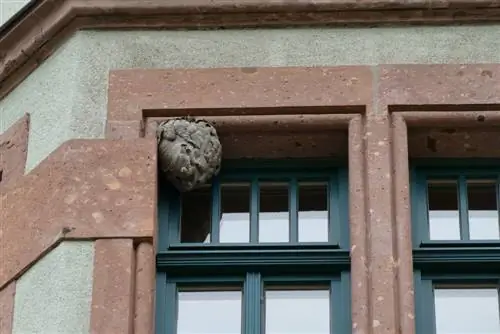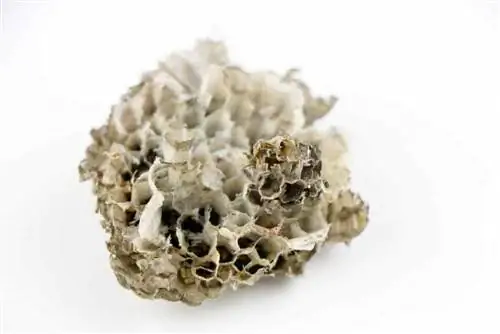- Author admin [email protected].
- Public 2023-12-17 03:39.
- Last modified 2025-01-24 12:45.
Under the roof is a popular place where wasp queens reside with their people. If the busy workers swarm out to bring food for the brood, it is difficult to prevent harassment of the house's residents. However, the law only allows wasp nests to be removed if there is a danger due to small children, seniors with limited mobility or people with allergies in the immediate area. These instructions explain in detail how you can legally get rid of wasps, remove the nest structure yourself and dispose of it correctly. Benefit from our tips on how to proceed professionally and safely.
Common locations for a wasp nest
If wasps are buzzing around in the living room or if the coffee table on the terrace is surrounded by buzzers, there is reason to assume that a colony of wasps has settled in your house. The dilemma begins unnoticed in March/April, when a young wasp queen makes her home a nesting place for her colony. Therefore, keep an eye out for a wasp nest in the following locations:
- Under the roof
- In roller shutter boxes or under wooden cladding
- In gazebos or old sheds
- Within niches in the masonry
In our latitudes it is primarily the German wasp and the common wasp that build a wasp nest in these locations as dark cave nesters for their people. These species are also responsible for the bad reputation of wasps, as they form by far the largest colonies with several thousand workers. If the nest is still under construction, there are significantly better prospects of preventing settlement by removing the shell yourself.
Obtain official approval
All wasp species are subject to the Federal Nature Conservation Act because their populations are endangered. Killing wasps, destroying their nests or otherwise disrupting their rhythm of life is punishable by high fines. If you have found a wasp nest that poses a threat to the residents of the house, you will need a special permit from the responsible authority to remove it. As a rule, the lower nature conservation authority or the municipal public order office take care of the matter. You will make the decision easier for officials if you add more information to the informal application. For example, a medical certificate that proves an insect allergy is helpful. If you can show with photos and explanations that the wasp nest poses an acute threat to the immediate surroundings of the apartment, the chances of a positive decision increase.

Tip:
Only when an application for a special permit is approved can a wasp nest actually be removed. During the processing time, it is advisable to cordon off the area around the nest. With the help of fly screens, the flight paths can sometimes be redirected so that at least sensitive locations in the house are no longer visited by wasps.
Protective Equipment
Wasps are not naturally aggressive. Rather, the workers work diligently and tirelessly to provide food for the offspring and the queen. However, if the wasps feel threatened, they defend their nest vehemently. If you approach the building to drive away the colony, you should only do so with protective equipment that is based on beekeeping equipment:
- Protective suit as overall with helmet and integrated veil
- Alternatively a beekeeper's shirt with a beaded collar, protective trousers, helmet and veil
- Sturdy gloves with long cuffs
- Rubber or leather boots
- Long-sleeved jogging suit
The veil should be fastened to the collar with snaps so that it cannot come loose as a result of hasty movements. If you pull a thin plastic cable through the bottom edge, the veil won't rest on your face with every gust of wind. We recommend additional protection of the neck with a collar, such as that used in trauma medicine after a whiplash injury.
Tip:
Before you remove a wasp nest yourself, please ask your family doctor to confirm that you are not allergic to the stings. Despite all precautionary measures, it cannot be ruled out that one or two infected wasps will penetrate the skin.
The best time
Choosing the right date for removing wasp nests has a significant influence on the successful outcome. The following times have proven to work well in practice:
- Ideally the nest is still under construction between April and August
- There is little activity in the nest at night
- Alternatively in the early morning hours, when dusk improves visibility
If you decide to have an appointment at night, please do not shine a flashlight on the nest. It is better to illuminate the building with red or yellow light, which does not attract the insects.
Plan escape route
However you want to remove a wasp nest; You will have to deal with aggressive insects that inflict extremely painful stings. Therefore, plan an escape route in advance that you can use to quickly get to safety. Walk the path to remove tripping hazards, such as toys or garden tools lying around.
Relocating instead of killing
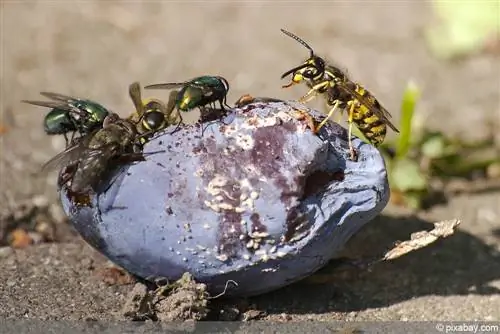
If the wasp nest is in a freely accessible location and can be easily removed from the underground, there is the possibility of relocating the entire colony. This measure makes an important contribution to environmental protection because wasps are an indispensable part of the ecological balance. Here's how to do it correctly:
- Put on protective clothing and close the entrance hole in the nest with construction foam
- Cover the wasp nest with a close-meshed net
- Separate from the base and put in an air-permeable bag
Transport the nest to a location approximately 4 kilometers away. Choose a partially shaded, wind-protected place to place the nest. Do not remove the bag and net until the nest is securely in place. Keep protective clothing on throughout the relocation. The wasps will remove the construction foam in the entrance hole on their own within a short time as they eat the material.
Tip:
Nature conservation associations and beekeepers will be happy to help you relocate a wasp nest safely and safely. The experts are also equipped to relocate larger populations so that the wasp colony does not have to be destroyed.
Poisonous wasp foam only outdoors
If a wasp nest is firmly attached to masonry or the roof in several places, there is a risk that it will break apart and a swarm of angry wasps will attack you. Since the option of relocation is no longer available, the focus is now on extermination with wasp foam. In contrast, wasp spray is too volatile to safely remove a wasp nest and is primarily suitable for combating individual specimens. Since the toxic substances pose a he alth risk to people and pets, chemical insecticides are only used outdoors. This approach has proven to be practical:
- Put on protective clothing at the recommended time and plan the escape route
- From a safe distance of 3 to 4 meters, completely cover the nest with wasp foam
- Let the insecticide work overnight
The next morning, check whether there is still life in the nest. If you can no longer register activity, place an insect net around the burrow as a precaution. Only then do you remove the nest from the surface and immerse it in a bucket of boiling hot water. Now you can assume that all larvae, workers and the queen have been destroyed.
Tip:
With nest dummies you can prevent wasps from re-establishing themselves. Since these insects attach great importance to their own territory, do not create nests that are in the immediate vicinity. You can make a dummy nest in no time with brown paper bags or use offers from the hardware store.
Dispose of abandoned wasp nest
If you have managed to drive the wasps out of the nest, wait until winter. In the period from November to April you can almost certainly assume that there will not be a single wasp left in the nest. The mated young queen looks for safe quarters for the winter, where she can survive frost and snow unscathed.
Break down an abandoned nest with a hammer or spade. After you have roughly removed the nest, scrape off the surface and carefully clean the area with a disinfectant. Remaining scents could entice a young queen looking for a place to live to settle in this spot again next year.
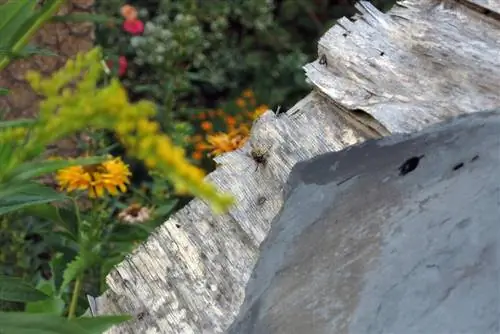
Since a wasp nest consists mainly of wood fibers, it is pure organic waste and can be disposed of in the compost. However, if you treat the nest with a chemical insecticide, it has no place in the compost heap. The remaining toxins could cause significant damage to the microorganisms. In this case, please dispose of the nest with household waste.
Tips for peaceful coexistence
Wasps, quite wrongly, have the reputation of being aggressive at all times and ill-tempered with the intention of stinging people and pets. The fact is that they are among the busiest creatures in the animal kingdom, pollinating plants and destroying pests. Unless a wasp's nest is located in a household with small children or a current allergy problem, peaceful coexistence is certainly within the realm of possibility. If you follow these tips, you can prevent painful conflicts on the one hand and genocide on the other:
- Never swat at wasps or blow on the insects
- Attach insect screens to the windows
- Always cover sweet and savory foods
- Don't leave drinks out in the open
- Wear white clothes when having a coffee chat on the balcony
- Lay lemon slices studded with cloves on the table
- Repel wasps with citronella scented candles
- Harvest ripe fruit in the garden on time
- Do not leave fallen fruit lying around for a long time
With a clever diversionary maneuver you can prevent hungry wasps from attacking the coffee table and causing panic among the guests. Place some cut, overripe grapes at a safe distance. As has been found in field tests, bowls filled with jam or honey are not suitable as a distraction as the insects react aggressively to these sweets.
Conclusion
If there is a wasp nest under the roof or in another location in the house, conflicts with the residents of the house can hardly be prevented. If you decide to remove the nest on your own, this is only permitted with a special permit. Wasps are subject to nature conservation and may only be combated if their presence poses a danger to small children or allergy sufferers. As long as a nest is under construction between April and August, you can relocate the busy colony. Large nests often require the use of wasp foam if the structure is in the open air. Equip yourself with a sturdy protective suit and take action against the wasps at night or in the early hours of the morning. As long as you do not introduce any chemical substances into a wasp nest, it can be disposed of as organic waste in the compost. Otherwise, the poisoned material belongs in the household or hazardous waste.

